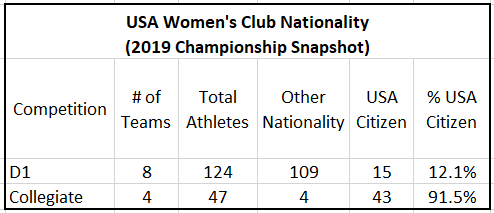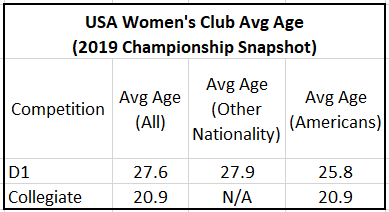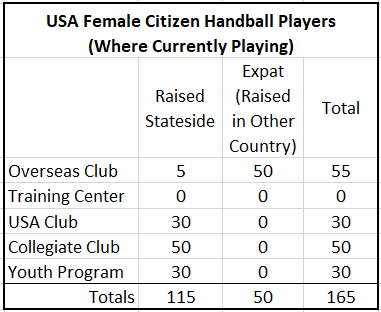
This article is part of a series, Charting a Way Forward for USA Team Handball (2019 Reboot)
A Brief Diatribe on Women’s Sports in the U.S
Like men’s sports, the structure and organization of women’s sports in the U.S. is significantly different from the rest of the world. But, in addition to the differences in structure, there is another major difference: higher participation rates. The numbers of girls and women playing sports in the U.S. pretty much dwarfs that of the rest of the world with the possibility exception of Scandinavia, Canada and the Netherlands. There has always been some great traditions of girls playing sports in the U.S., but with the passage of Title IX legislation in 1972 there was a gradual and epic sea change in participation because… it was the law.
The rest of the world has seen this with our Women’s soccer program. While the U.S. Men might be respectable (even if we failed to qualify for the last World Cup) the U.S. Women are steam rollers. It’s kind of incredible when you think about it. When I was a kid, soccer was an afterthought sport for both boys and girls. Little organization, few youth programs and nobody cared. Now it is played coast to coast by millions of kids. And, as a result… we have a respectable Men’s national team and a juggernaut women’s team. Yes, overnight the U.S. had more girls and women playing than any other country.
And, this even includes European countries. As the U.S. is populated with a sizable number of European descendants it’s sometimes common for Europeans and Americans to think that the U.S. is pretty much like Europe except for that puritan aspect and, in some cases, a different language. This is often accurate, but not always. Case in point: Check out this NPR story about women’s soccer in France and the cultural struggle they’ve had to overcome regarding how soccer is for boys, not girls. And, that if you are girl playing, you must be tomboy. Seems rather quaint and old fashioned doesn’t it?
So, what does this Title IX thing mean in terms of international competition? If, (and this is a big if) the U.S. “cares” about a women’s sport, it’s pretty much a given that the U.S. will kick butt in that sport. And, by “care” I mean providing support to the sport in schools and colleges. Because if that happens we will have so many girls playing the sport that we can’t but help put together a great team. But, if a particular sport doesn’t have that Title IX support… Well, then chances are we aren’t going to be very good. Why? Because all of the “good” athletes will be playing the sports that get support.
And, that support is manifested in Middle School, High School and NCAA sanctioned sports. NCAA sanctioning is of particular importance due to the scholarship support that typically come with NCAA recognition. One does not have to look very hard to see a strong correlation between which sports the U.S. is not very good at and which sports aren’t NCAA sanctioned. And, while this is also true with Men’s sports the problem is further compounded for Women’s sports. This is because the overall pool of women athletes (for all sports) is smaller than it is for men. And, because Title IX has become a forcing function for equity there are simply more scholarship opportunities for women athletes. And, in turn, this means that there are fewer women athletes (lacking a scholarship) and therefore looking for a new sport like team handball.
The point of this diatribe: To help the reader understand why women’s participation numbers for team handball in the U.S. are dramatically smaller than men’s participation numbers. And, why improving female participation numbers might be even be more challenging.
Women’s Team Handball Organizations and Activities in the United States
The structure of Women’s team handball in the U.S. is pretty similar to our Men’s programs. Similar, but on an even smaller scale.
Training Centers: A Training Center is a place where handball is taught intensively. Two common examples: A European style Academy and what the U.S. has called Residency Programs in the past. Currently, there are no handball training centers in the U.S., although the youth program in Chicago has some elements of an Academy, albeit on a smaller scale.
Clubs: There are approximately 8 adult women’s clubs in the U.S. These clubs vary significantly in terms of size, organization and level of play. Currently, with the exception of Club Rogue every single one of these clubs is composed almost entirely of expats living in the U.S. And, Club Rogue, hardly fits the traditional definition of a club. It is simply a collection of current and former national team athletes living in multiple locations that gets together a couple of times a year for weekend tournaments.
Collegiate Clubs: An important subset of clubs are collegiate clubs which are affiliated with a college or University. There are currently just 3 women’s collegiate clubs in the U.S. It should also be emphasized that collegiate club sports are dramatically different from sanctioned NCAA sports. There are no scholarships and colleges typically only provide top level support. As athletes are college students, in most instances they are ages 18-23.
Youth Programs: These programs consist of athletes in Middle School (ages 12-14) and High School (ages 14-18). There are two fairly well established programs in the U.S., one in San Francisco and one in the Chicago. Approximately 10 girls are participating in the San Francisco area and they play on teams that are predominantly male. Approximately 20 girls are training in Chicago in preparation for the IHF Trophy tournament in October.
Other Activities: Team handball is played in Physical Education classes in hundreds, maybe even thousands of schools. This handball, however, is often just a rough facsimile of the game, taught by teachers unfamiliar with the sport, for a few lessons and with a lot of rule variants. There are also a number of colleges with intramural programs. (Intramural sports are lower level competitions where multiple teams at one college play each other.) Again, the handball that is played is often just a facsimile of the game we are all familiar with.
USA Women’s Club Demographics (2019 National Championship Snapshot)
This past April and May the U.S. staged its Collegiate Club and Club National Championships. Unlike European countries there is no nation-wide league and these championship events played over only 3 days are open to all comers. A Canadian club from Alberta even participated and their attendance alone resulted in the strange situation of more Canadians than Americans playing at the U.S. national championships. This chart breaks down the total participants in these 2 events.


(Note: Citizenship data in these tables relied heavily on roster names to assess nationality. Such an assessment surely is prone to error as Americans don’t always have “American Sounding” names and conversely some expats have deceptively “American Sounding” names. Overall, though I would assess that it’s a pretty good ballpark data.)
A few obvious points from these tables.
- An overwhelming majority of our Club National Championships participants are not U.S. citizens
- An overwhelming majority of our College National Championship participants are U.S. citizens
- The Avg age of participants at Club National Championships is several years younger than it is for the men. (I’ve got no hard data to back this up, but I bet it’s because women are a bit smarter than men when it comes to deciding when to retire from the physical sport of handball)
- While this data is similar to the data compiled for the men, the total numbers are significantly smaller
U.S. Citizen Demographics (Female)
In terms of National Team planning it is, of course, a necessity to focus strictly on U.S. citizen demographics. The following tables break out the citizen representation from U.S. clubs and adds estimates for expat Americans playing overseas and youth program participation. These estimates were based on extrapolation of National Championship data and National Team roster data. For USA based numbers I added athletes based on known clubs that didn’t attend nationals. For overseas numbers I took the number or expat players that have played on Sr, Jr, and Youth rosters the past 10 years or so (25 total) and doubled it, figuring that would conservatively account for unknown or lower level players. Anecdotally, I would assess that the yearly total is higher at younger ages and gets significantly smaller as players age out. For the most part I tried to error on the conservative side. The only exception is that I did not pad this data with the inclusion of school Phys Ed programs and college intramurals.

Key Points:
- The number of active women’s handball players based in the U.S. is really, really small. Depending on one’s semantics it’s around 100 athletes (or maybe less)
- Question: Should this stark reality be considered a “crisis”? And, if so what steps should be taken to address it?
- Question: Or, does the phrase, “It is, what it is” apply here?
- Because there are virtually no players being produced through grass roots it’s not hard to see why our women’s national team has relied on older athletes from other sports and expat players. The harsh reality is that we would be hard pressed to field a national team otherwise.
- Question: Should the U.S. continue to recruit older athletes from other sports and then expend limited resources on training those athletes?
- Question: Or should USA Team Handball “bite the bullet”, forgo a quick national team fix and address this huge discrepancy.
- The only level of competition that is structured somewhat normal (right age; predominantly American) is our college championships
- Question: Should we expend resources to further develop the women’s college game or does the overall lack of available, interested athletes suggest that efforts should be focused elsewhere?
This is meant only as a top level analysis. In a future article I will take a closer look at the U.S. Elite Player Pool and the pathways for athletes to enter this pool.